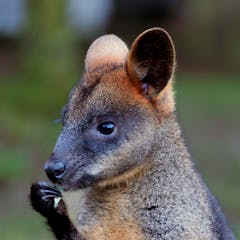
Articles on native animals
Displaying 1 - 20 of 22 articles

The delicate mouse – widespread across Australia – has turned out to be three different species. This will help to save them from habitat loss.

Each year, hungry plant-eating animals do billions of dollars of damage to valuable plants. We need prevention methods that don’t involve killing them.

Antechinuses are tiny marsupials famous for their intense sex lives. Now, researchers have documented another unusual behaviour – the cannibalism of their own species.

Most Australians think of scorpions as exotic desert animals, but they are fairly widespread across the continent. Still, next to nothing is known about most local scorpion species.

Contributors to the WomSAT website have already reported more than 23,000 wombat sightings. We can use the data to cut the risks to wombats – and anyone with a smartphone can help.

There’s been a long-standing debate over whether dingoes started out wild or domesticated. One thing is clear – they had a close relationship with First Peoples.

After combing through museum collections, our team of researchers found a whopping 125 fluorescent mammal species – from polar bears and dolphins, to leopards, zebras and wombats.

Echidnas are seemingly everywhere in Australia, from the Red Centre to snowy mountains. And that’s just the start of what makes them interesting

Brain samples of a thylacine that died in 1880 in Berlin were kept safe by researchers for decades. Now, they have finally been analysed.

Researchers are in a race against time to learn about the female-oriented social structures of Australia’s small native rodents and marsupials.

Our medicine, cosmetics and other everyday products contain compounds taken from nature. But Traditional Owners may not have given permission for the materials or their knowledge to be used.

A single colony of bees can have 60,000 bees in it. Together, they can visit up to 50 million flowers each day to collect pollen and nectar. They’re not called ‘busy bees’ for nothing!

Wet and bulky cattle dung is very unlike marsupial dung that Australian dung beetles are adapted to deal with, meaning native dung beetles tend to leave it alone. But help from abroad is at hand.

In NSW, honeybees are listed as a key threatening process to biodiversity.

Introduced species are often targeted for culling in conservation, but killing charismatic animals like foxes can be controversial.

Thousands of people in Australia and around the world have rallied to knit and crochet comfort items for wildlife. Their efforts are the latest in a long history of crafting for a cause.

Of all Australia’s wildlife, one stands out as having an identity crisis: the dingo. New research has found the dingo is its own species, distinct from ‘wild dogs’.

As soon as white colonists began farming sheep in Australia, they looked for a way to eradicate dingoes.

Australian wildlife can generally cope with drought, but they’re not prepared for the combination of people, introduced animals, and no water.

Bushfires are a part of life in Australia, and when they have run their course we pick up where we left off and carry on. But if you happen to be a small animal, surviving the bushfire is only the start…
